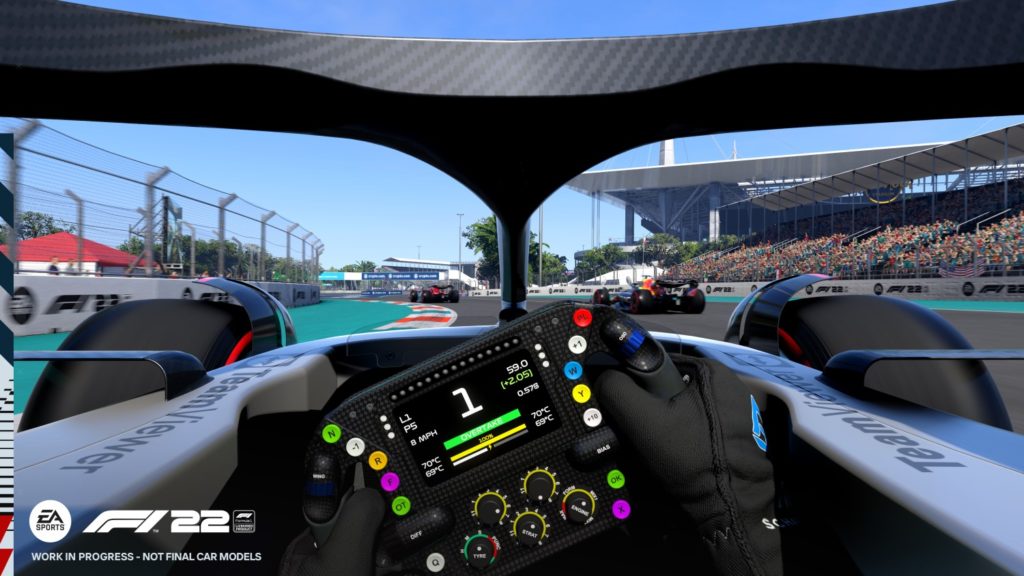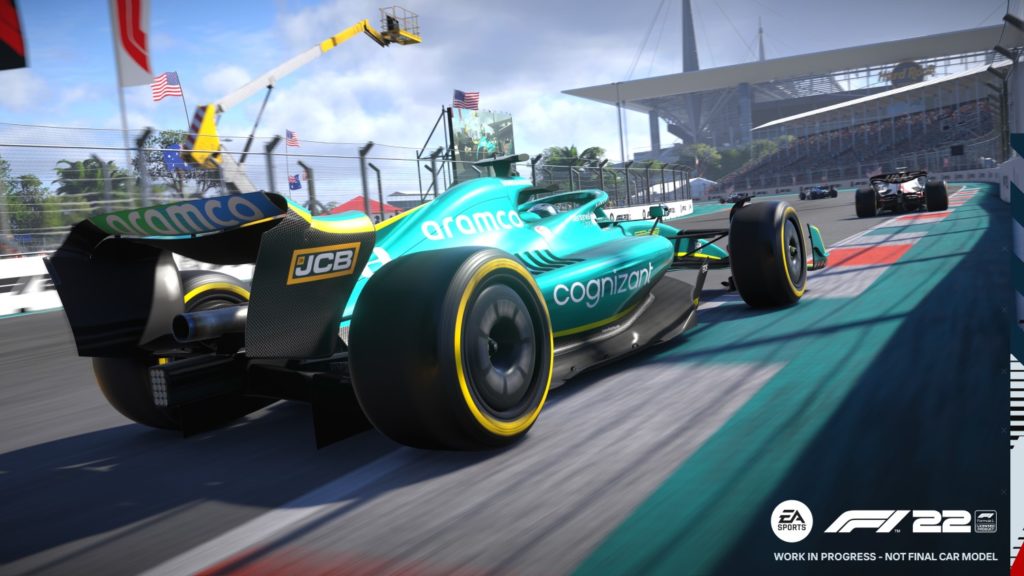We’ve been playing a preview version of F1 22, and we’re now allowed to give you our impressions of the brand new Miami circuit which will host its first race on May 8.
A mere four races in, this burgeoning Formula One season is already looking like it could assume epic proportions. Much of the credit for that can be attributed to Liberty Media which, since it took over the commercial running of the sport in 2017, initiated a far-reaching shake-up culminating in this year’s new regulations, which finally allow the (infinitely better-looking) cars to run much closer to each other and therefore to race properly.
But another big move by Liberty Media (perhaps welcomed more by fans than the teams) has been to expand the roster of tracks, bringing back a handful of old favourites that had fallen off the calendar and adding completely new circuits. This weekend, Sunday 8 May will see the Formula One circus hit Miami for the first time – which, with its innate, sun-kissed glamour (think Art Deco condos, palm trees and white sand beaches) would seem like a perfect fit for F1’s status as the blingiest of sports.
On track in F1 22
The Miami circuit, typically for a new addition to the F1 calendar, is a street track, so at the time of writing, it’s literally having its finishing touches applied. Yet I’ve spent the last couple of days driving around it – in a preview build (on PC) of F1 22, the latest Formula One game crafted by Codemasters and published by EA Sports. As a result, I can say with some confidence that it will be a real surprise if the Miami track doesn’t end up becoming a valued component of the F1 schedule.
At this point, I’m not allowed to tell you much about the game – there’s a preview embargo in place on that front which expires just after the Miami race weekend. However, I am now allowed to share my impressions of the Miami track itself, gleaned from driving around it in F1 22.

Among Formula One fans, street tracks don’t necessarily have the best reputation – too often, due to the constraints imposed by taking place on public roads, they end up being tight, twisty, technical and slow, with their typical narrowness providing few chances for overtaking. But street tracks needn’t necessarily be like Monaco or Singapore, as the Baku track, which joined the calendar in 2017, along with the long, super-fast Jeddah street circuit, which debuted last year (and this year saw Verstappen hold off Leclerc for victory by just half a second) went some way towards proving.
Fast, but satisfyingly technical
We would say that Miami kind of sits between Baku and Jeddah in terms of the driving experience it offers, with perhaps the odd hint of Melbourne. It’s a long track, at 5.412Km, and if the game is realistic, this year’s cars should be able to lap it, in full qualifying, everything-turned-up configuration in around 1 minute 36 seconds.

So what is it like to drive? Its first section, off the grid, doesn’t initially feel like a street circuit, since it’s much less narrow than you would expect, and most of the corners have a generous amount of tarmac run-off. That doesn’t last, though – the circuit narrows markedly from the first of its three straights onwards, with plenty of barriers lurking to nip off the front wings or wreck the suspension of the imprecise.
Turn One could see some shenanigans off the line – it’s a fairly tight right-hander, but with the grid assembled, the run up to it is short, so the cars, at least at the front of the grid, won’t be up to particularly high speeds when they reach it. In the race, though, it could provide overtaking opportunities, as the run up from the hairpin Turn 17, at the end of the back straight, is quite long and quick.
Turns 2 and 3 are medium-speed, sweeping corners, which won’t quite be taken flat-out when the cars have heavy fuel loads, so again off the start, drivers could easily capitalise if cars in front find themselves going wide. A high-speed left-right complex leads into the tight Turn 7, which feeds into a long straight which, rather like Baku, is kinked but long. That’s where the track gets narrow, so overtaking will require a lot of bottle.
But if the car you’re following gets a poor exit from Turn 7, it should be possible to set up a pass into Turn 11, a 90-degree left-hander at the end of the straight, particularly since the DRS can’t be enabled until you’re a fair way down the straight.
Turn 11 marks the start of a very tight complex of corners which are so low-speed that you almost feel as though you’re driving around Monaco. Get it wrong there, and you can lose a massive chunk of time (which will have an impact in qualifying, although in the race, you’ll just have to sit behind any car you follow into that complex – it’s far too narrow for any overtaking).
Then you’re into a long, again narrow, back straight with barriers either side (and picturesque palm trees beyond those barriers). DRS opportunities should be plentiful there, too, since Turn 17, at the end of the straight, is a proper hairpin. We might also see some fighting back from cars overtaken in Turn 17, if they get better exits through the sweeping left and right-handers that lead onto the short start-finish straight; once racing gets under way, you’ll find yourself approaching Turn 1 much quicker than when you were getting off the line, with the fairly technical Turns 2 and 3 lying in wait.

Low-downforce setups
With two notably long straights and another shortish but significant one – all three of which let you employ DRS – you can envisage plenty of potential overtaking points. Most obviously at Turns 1, 7 and 17, but the more adventurous overtakers in the Formula One pack may also try moves at Turns 3, 4 and 5, which require a certain amount of rhythm not entirely unlike Silverstone’s Maggots and Becketts.
But the inclusion of the low-speed complex formed by Turns 11 to 16 is interesting. It’s pretty obvious that all the teams will want to employ Monza-style ultra-low downforce configurations, making the cars slow, gripless and clumsy around that sequence of corners. We could see a few drivers getting greedy in that complex and sliding off, particularly into the barrier at the start of the back straight, or leaving themselves vulnerable to a DRS move on the back straight which follows. Being too slow around the complex could also compromise cars’ qualifying pace, while cars running a slightly higher level of downforce could profit during qualifying in the complex, but would soon become sitting ducks in the race, where top speed along the straights will be paramount.
Likely to produce an exciting race
After years of low-level grumbling about identikit Hermann Tilke circuits and sub-par street tracks, Miami looks like it should provide the basis for an intriguing race. You would definitely want to eliminate porpoising on its three straights (fingers crossed for Mercedes’ efforts on that front), but with the cars now able to follow each other, we should in theory see plenty of overtaking.
You also wouldn’t rule out the possibility of numerous safety cars or even the odd red flag. On the narrow back straight, in particular, tiny miscalculations under DRS could lead to the sort of carnage that would see the track liberally strewn with carbon-fibre. And in general, it’s a new, unfamiliar and in parts notably technical track, so it will test the drivers’ skill levels.
Having said that, it’s a fast and exhilarating track which is enormous fun to drive (bar the somewhat frustrating twisty complex). We reckon the drivers should love it. And since it’s in Miami, it’s fair to say that we can expect some major glitz in the build-up to the first race around it.
